I’d been walking for 2 hours and my stomach was reminding me it was time to stop for a “second breakfast” as we call it on the Camino de Santiago. My first breakfast had been very Spanish: coffee and a toast with tomatoes. Though, honestly, many Spaniards would omit the toast.
I’d met a few Spaniards that morning, and when we came to a half-wall with a spray-painted image of the words “Ultreia and Suseia,” those of us who’d walked Caminos before knew there was pilgrim support coming soon. These words were a medieval greeting—and offer of encouragement—among pilgrims. “Ultreia” means further or beyond and “Suseia” means higher or upward. (In Medieval times, the first pilgrim would say “Ultreia!” and the second would respond with “Suseia!” Today, the pilgrim greeting is “Buen Camino,” though I’d love to add the Ultreia/Suseia back into the tradition!)
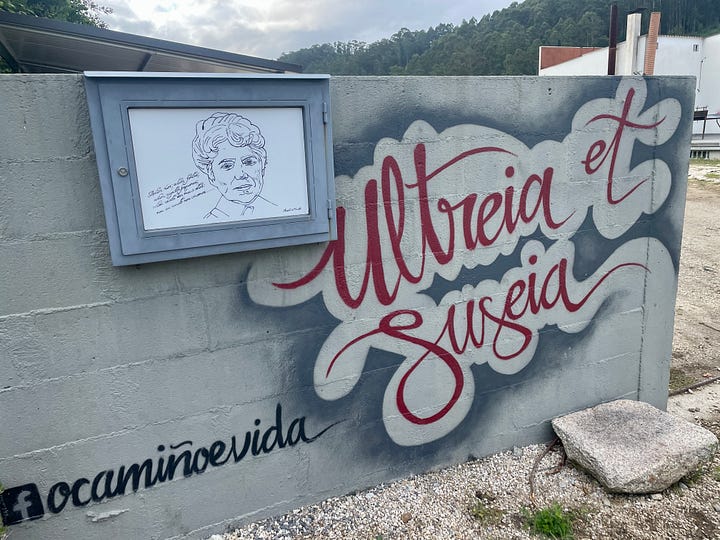
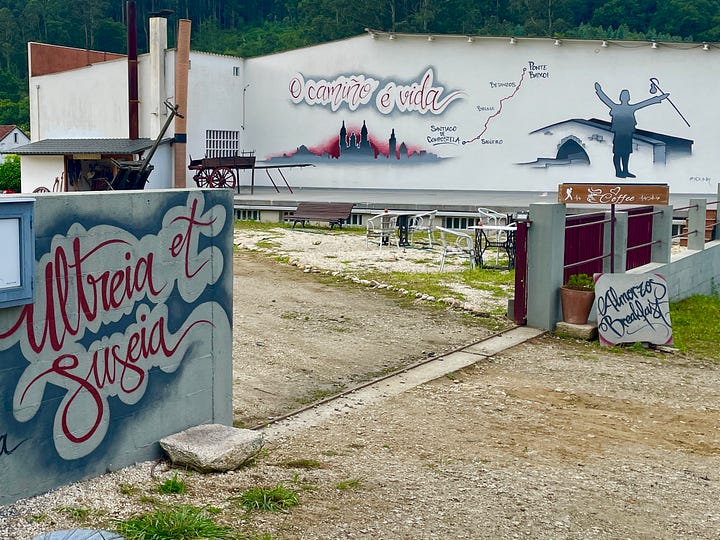
Just beside those words of greeting, there was an opening in the half-wall. Off to the left, there was a covered picnic area, its tables dotted with pilgrims eating, drinking, and conversing, their backpacks of all sizes beside them or against the back wall.
We found a table, dropped our packs, and went to check out the offerings. Beyond the picnic area was a small, low-slung building. My fellow Americans would think there wouldn’t be much inside such a small space, but those of us that know Spain know the Spaniards have an incredible way of creating all sorts of things in small spaces like this.
Inside, a woman with short hair and glasses attended to the few pilgrims in the line in front of us. Options included drinks (hot and cold), empanadas, tortilla de patatas (a thick egg and potato crustless quiche), croissants, and sandwiches. There were various Camino souvenirs one could buy and, on the opposite side of the room, a sparkling-clean bathroom with a 4-foot high medicine cabinet holding a cure for any need a pilgrim might have.
In other words: we’d found Camino pilgrim heaven.
Someone bought drinks, some of us got food, others took a bathroom detour, and five minutes later we were all gathered around the table eating, drinking, and chatting with other pilgrims.
As the number of pilgrims thinned, one of our group greeted the owner who was clearing tables. And so it was that we learned about Rocio.
Rocio was a carpenter. Across the gravel lot from where we sat was a large building that used to be her workshop. As this was the first structure pilgrims saw after a couple hours of walking, they’d often stop in and ask for some water, which Rocio would graciously provide. She’d been doing this for dozens of years—long before most of the world had ever heard of the Camino, let alone this route (the Camino Inglés).
When COVID came and furniture sales declined, she decided to pivot. She closed her factory and took this space that once offered a respite and free water source to pilgrims and turned it into what it is today. She decided to dedicate herself at that point to the care of pilgrims.
But now she’s ready to retire. Her land and buildings are worth a sizable bit of money but she only wants to sell to someone who would continue to serve pilgrims from this space at the back of the parking lot. (It’s not easy to subdivide property here in Spain.)
So she’s hoping that the Camino will provide a solution for her.
When we left, I asked my Spanish friends to confirm the story she told to be sure I understood all the Spanish. “She said the beer company might want to buy it?” I asked. “Well, they know about her,” my new Spanish friend explained. “They painted her on one of the buildings.”
I still wasn’t sure I understood exactly what was going on, but 20 minutes later, there she was, four stories tall.
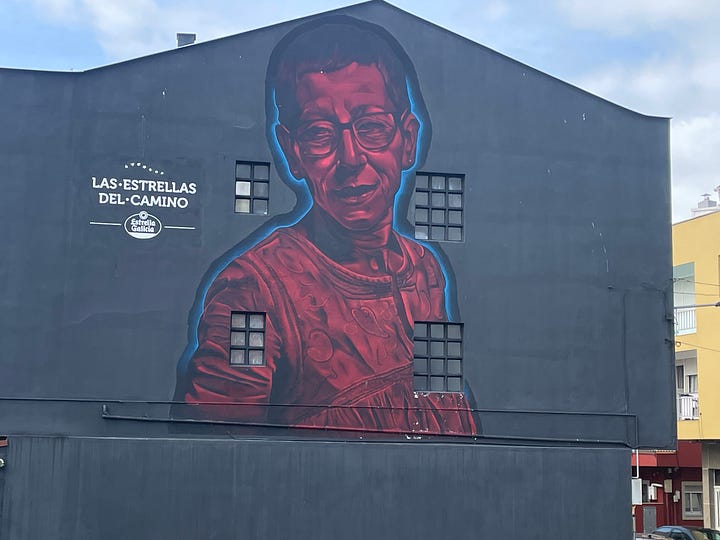
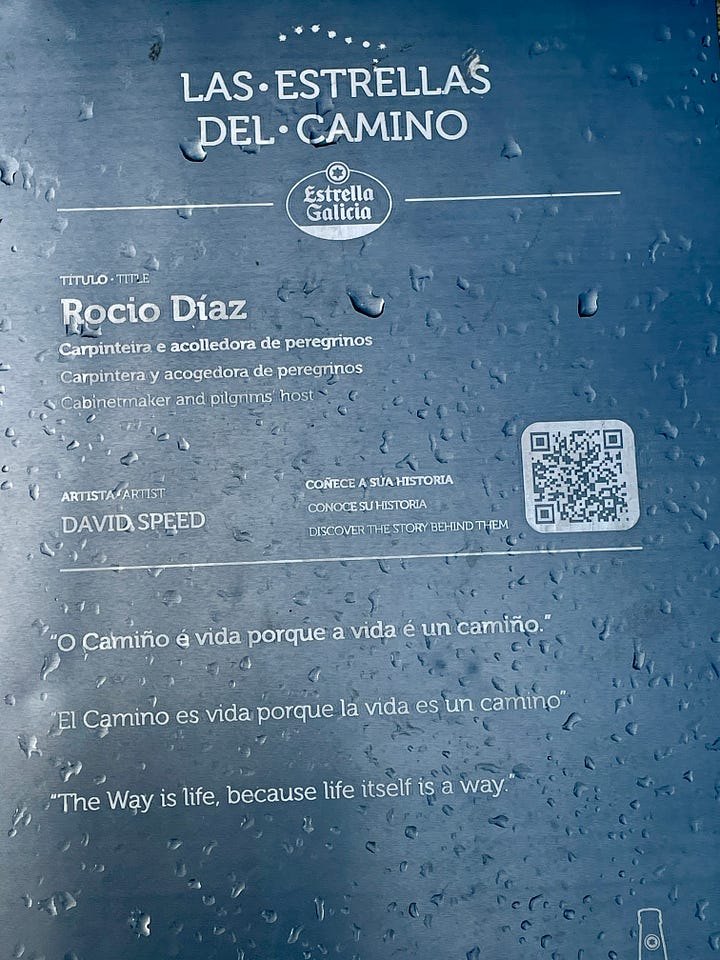
I’d seen the paintings along various Camino routes—black and red, taking up the side of a four story apartment building, easily in view of the pilgrims walking the Camino. “Estrellas del Camino” it says beside them: Stars of the Camino. I recognized the logo beneath these words as that of Estrella Galicia beer. I’d seen one of these murals earlier on this route and read the sign below it that told us about José Carlos Pita López. After dictator Francisco Franco’s death, José Carlos was the first democratically elected mayor of Neda (a town on the Camino Inglés). He served in that role for 38 years. When he started his work, the town had no paved roads, no highways. One day, in the town archives, he found mention of a Camino route through the town. And thus the beginning of the recovery of the Camino Inglés.
I finally understood: the beer company has chosen to honor people who have made a significant impact on the Camino in their area.
When Rocio said the beer company might be interested, I realized she was saying they knew about her thanks to the painting.
This prompted me to do a little research. I wanted to know more about this campaign by Estrella Galicia.
It started in 2021, with seven murals painted along the Camino Francés. In 2022, 10 murals were painted on the Camino Portugués. And in 2023, Estrella Galicia hired artists to paint 6 murals along the Camino Inglés.
The Estrella Galicia website tells the stories of the subjects of each mural as well as the artists. The “exhibition” now covers over 500 km of Camino routes in the province of Galicia.
—
My first Camino, back in 2012, was all-encompassing. I was overwhelmed by the generosity not just of other pilgrims, but of these locals. I marveled that a country could pull off something like the Camino. Many of the trail markers at that time were painted yellow arrows—maintained/touched up by the locals to help direct the pilgrims. I remember a women in León dressed in hospital scrubs who, when I asked her to point me in the direction of the Camino, left the bus stop to walk me 5 minutes out of her way to get me back on the trail.
I have dozens of stories from Camino routes just like this—the cherry farmer who stopped his tractor and encouraged my father and I to take some of the harvest. “Más, más!” he kept telling us (more! more!). The man checking his olive trees who took the time to explain to me that you can’t just pick an olive off a tree and eat it—it would taste terrible. I had no idea! The woman who, sitting at her table under an umbrella on a very warm day, took our water bottles into her house to refill them.
So these Stars of the Camino? You don’t just find them painted on murals. They exist throughout the country—and, having walked Camino routes in Portugal and France, I can tell you they exist there as well.
In fact, I dare say there are generous, kind-hearted people all around the world. I’d bet the majority of people wouldn’t hesitate to help another.
My mother once said, “If the world could operate the way the Camino does, it would be a much better place.”
So I invite you to come and restore your faith in humanity. Not just to take this Camino experience home with you, but to be part of the culture of giving and receiving and to bring that back with you.
But you don’t need to have walked the Camino to be open to those that may need a hand, a kind word, a hug. Please: be kind to one another. Be a Star.
With love,
Renaissance Rebecca
What is this?!
To those of you that haven’t known me very long, you may be wondering what’s going on. I usually only post on Sundays. And then put up the weekly Camino Conversations interview during the week. But a Camino story on a random Tuesday?
Those of you that have known me longer know exactly what this is: RenaissanceRebecca is back!
Whenever I feel the urge, I’ll be sharing stories from my life at home and abroad, the people I meet, the connections I make—Camino or otherwise.
As of this moment, if you’re a subscriber, you’ll receive both my nuts-and-bolts/ Camino inspiration posts as well as Renaissance Rebecca posts (like the one above).
If you want to opt out of one of them, just click on your Substack profile (upper right corner) and go to “account settings.” Click “edit” and uncheck a box as appropriate.
🥾Ready to start planning your Camino?
Rebecca Weston
Camino Planning & Preparation Guide (for People 45+)
Rebecca@TheCaminoCalls.com
Your Camino adventure should feel exciting, not stressful — here are some ways I can help you get ready:
🎥Watch Camino Conversations for practical tips and advice from my guests who have done the Camino (or more than one!).
🗓️ Camino Planning Session (45 min): Get answers to your top questions and a notes doc created during our call.
📞 Full Camino Experience: 6 coaching calls with detailed notes to plan your trip with confidence and ease.
🥾 Walk With Rebecca: 7-day hybrid Camino walks — 3 days guided, 4 days independent, private rooms, preparation classes, and optional check-ins. Click here to be the first to be notified about my next trip.
About me: I walked my first Camino in 2012 . Since then, I have walked over a dozen Caminos—alone or with others; in spring, summer and fall; in Spain, Portugal, and France. I’ve also spent many days volunteering along the trail, and if I’m not walking one now, I’m planning the next—and would love nothing more than to help you plan yours, too. My husband and I live in a town of 6500 people on the Camino del Norte.




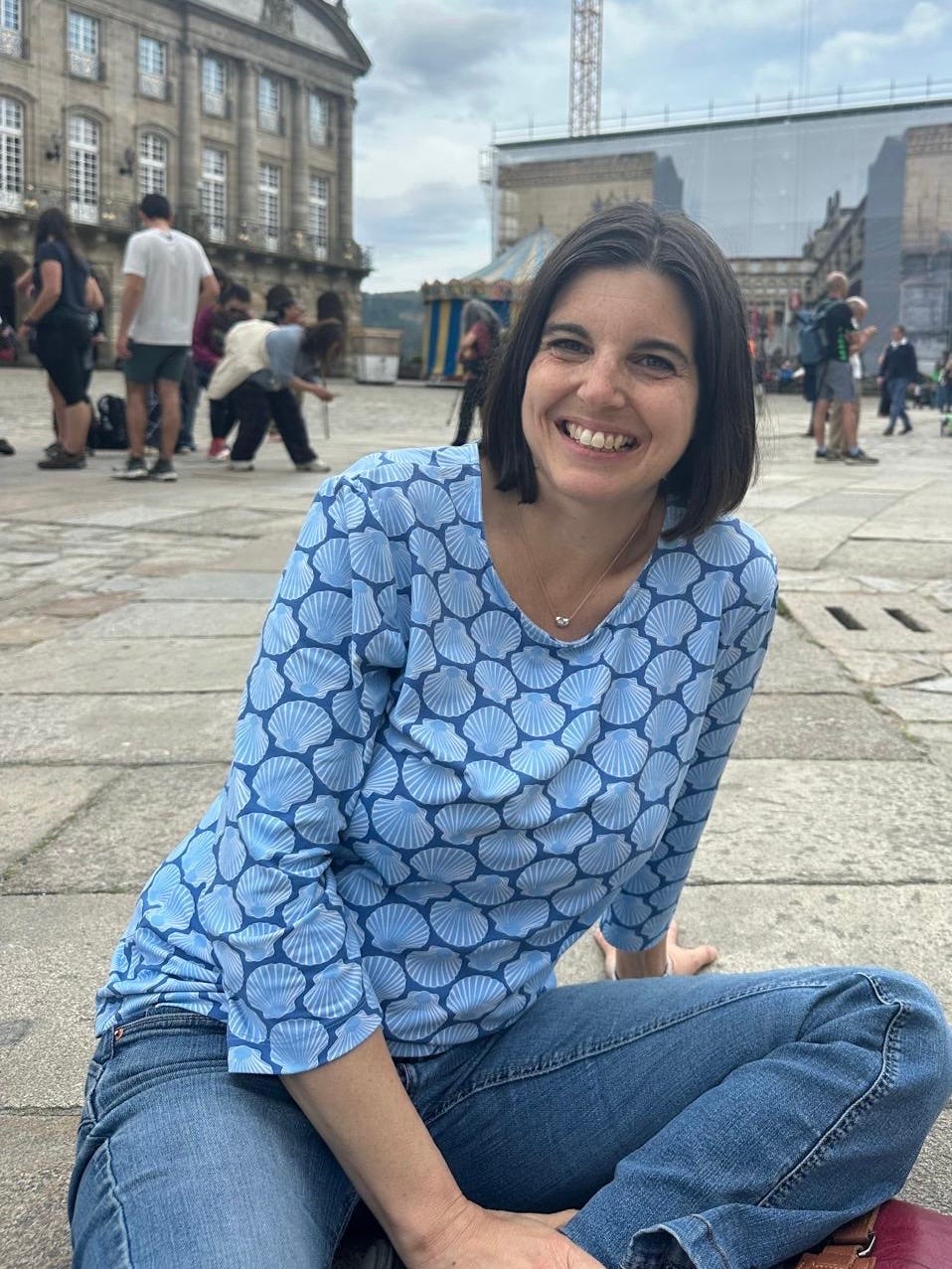
The Camino so open, welcoming. And, thank you for being curious and sharing the story of the murals.